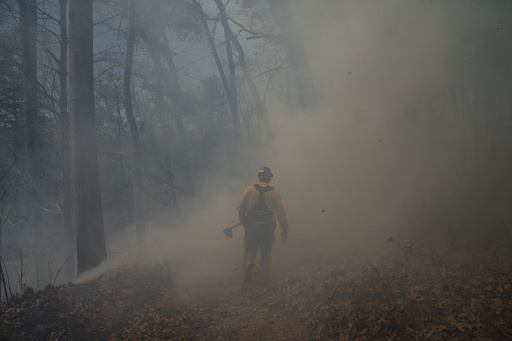In North Carolina, wildfires are raging uncontrollably due to unseasonably dry conditions and leftover debris from last year’s Hurricane Helene. In Florida, numerous fires have erupted, including a significant one that burned approximately 42 square miles in Miami-Dade County. Fires are also persistent in Oklahoma, where recently, four individuals lost their lives to blazes driven by strong winds. These are just three of the eight states experiencing major wildfires as reported last Friday.
As per data from the National Interagency Fire Center, about 14,800 wildfires have consumed 1,105 square miles this year, far surpassing the decade-long average. Among the most severe incidents were the Los Angeles fires in January, exacerbated by parched vegetation and fierce winds, which obliterated entire communities.
Frequent wildfires in recent years have led U.S. fire experts to conclude that there is no longer a defined “fire season.” Normally extending from late spring into fall, it has been altered predominantly due to climate change. The combustion of fossil fuels like gasoline and coal has elevated average global temperatures, fostering drier conditions that permit more intense and prolonged wildfires, largely ignited by human actions.
While large-scale fires usually occur earlier in the year, as noted with Texas’s largest wildfire on record in February 2024, this year’s outbreak is exceptional due to its widespread occurrence across multiple regions, according to Brad Rippey, a U.S. Department of Agriculture meteorologist specializing in drought observation.
Currently, 45% of the nation is experiencing drought, a stark contrast to the typical 20% at any given time, Rippey mentioned. This situation has dried potential fuel sources, ready to ignite—from freeze-dried grasses in the southern Plains to downed trees and brush left after hurricanes that have battered parts of the southeast and southern Appalachians in recent years.
The National Interagency Fire Center’s outlook highlights that several states still contend with debris from hurricanes Laura, Ida, Debby, and Idalia over the last five years, alongside remnants from ice storms and severe weather.
With gusty winds and low humidity, “you’ve got a potentially explosive situation for wildfires,” said Rippey.
In North Carolina, hit hard by Hurricane Helene, fallen power lines due to strong winds have ignited two out of three large fires that have burned for over a week. In addition, the mean relative humidity this month has reached its lowest on record, officials note. Impenetrable areas and numerous fallen trees complicate efforts to combat the rapidly spreading fires, exacerbated by high winds and dry conditions.
“Many roads are either buried under storm debris or they have been completely washed away,” said Philip Jackson from the North Carolina Forest Service, warning that the fire threat may persist for years as more debris dries out.
Drought conditions are also affecting much of Florida, resulting in an early fire season, including a vast brush fire in Miami-Dade County that at one stage disrupted travel to and from the Florida Keys. This fire is now mostly contained, but smaller fires continue to persist across the region. Many counties are under red flag warnings, signaling favorable conditions for fires to ignite.
Additionally, West Virginia, Tennessee, Georgia, Missouri, and South Carolina report notable wildfires. The National Interagency Fire Center predicts the highest wildfire risk in the southeast and southern Plains, persisting significantly through April across most of Texas, parts of New Mexico, Arizona, and several southeastern states.
Tim Brown, director of the Western Regional Climate Center, suggests that La Nina, a periodic cooling of the Pacific Ocean affecting the jet stream and air conditions, may have influenced the southern U.S. However, Rippey points to long-term drying in the southwest, as global warming raises temperatures, leading to more unpredictable precipitation patterns. This results in quicker rainfall runoff rather than it being absorbed by the ground, which “definitely contributes to more wildfires,” he stated.



